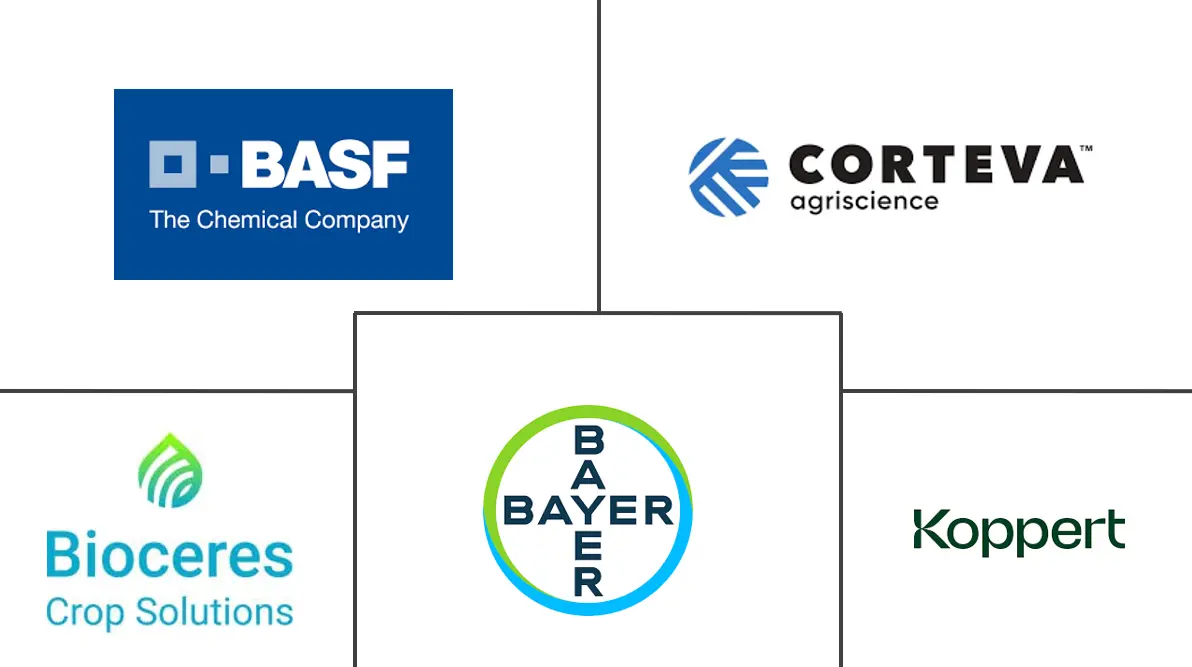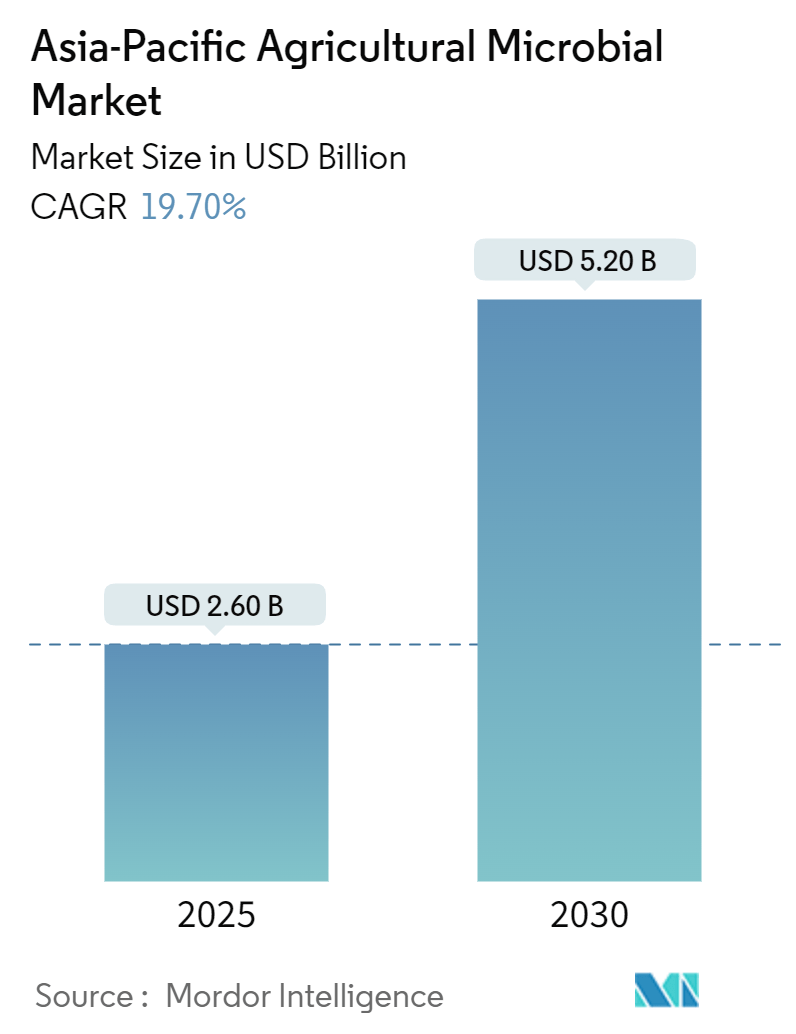
Asia-Pacific Agricultural Microbial Market Analysis by Mordor Intelligence
The Asia-Pacific Agricultural Microbial Market size is estimated at USD 2.60 billion in 2025, and is expected to reach USD 5.20 billion by 2030, at a CAGR of 19.70% during the forecast period (2025-2030).
Microbial products enhance nutrient availability, promote root growth, and protect plants from diseases, increasing crop yields and farmer profitability. Asia-Pacific countries have relied heavily on chemical inputs to meet the food demands of their growing populations. According to the Union Ministry of Agriculture and Farmers Welfare, Indian farmers used approximately 60,000 metric tons of chemical pesticides annually between FY 2020-2021 and FY 2021-2022. The increasing concerns about chemical residues in food have created a demand for crops grown without synthetic chemicals. In 2023, the European Commission detected pesticide (chlorpyrifos) residue in turmeric imported from India. Microbial solutions provide a practical alternative for producing residue-free crops.
Governments across the Asia-Pacific region are implementing policies and initiatives to promote organic farming through subsidies and awareness campaigns, which increase microbial product adoption. The Vietnamese government has shown commitment to organic agriculture development through targeted policies. As of late 2023, Vietnam allocated approximately 495,000 hectares to organic farming, accounting for 4.3% of the country's total agricultural land. The increasing residue levels in agricultural produce and government support for organic agriculture is expected to drive the agricultural microbial market growth during the forecast period.
Asia-Pacific Agricultural Microbial Market Trends and Insights
Rising Production of Fruits and Vegetables
The Asia-Pacific region leads global fruit and vegetable production, with China and India as the primary contributors. China produced 619 million metric tons of vegetables in 2023, accounting for 66.6% of Asia's vegetable production. The country also generated 269.3 million metric tons of fruits, representing 48% of the region's production. Asia's vegetable production increased from 919 million metric tons in 2022 to 929 million metric tons in 2023, according to FAOSTAT. This substantial production volume, combined with increasing organic agriculture awareness, drives the regional agricultural microbial market.
The Asia-Pacific region demonstrates significant growth in organic farming practices. Microbial pesticides provide selective pest control by targeting specific pests and related organisms, contrasting with conventional broad-spectrum pesticides that affect birds, insects, and mammals. FiBL Statistics report that the region's organic vegetable cultivation area reached 33,497.7 hectares in 2022, which is more than the previous year's area of 33,191.6 hectares. This rise in organic area under vegetable cultivation is fueling the agricultural microbial market in the region.
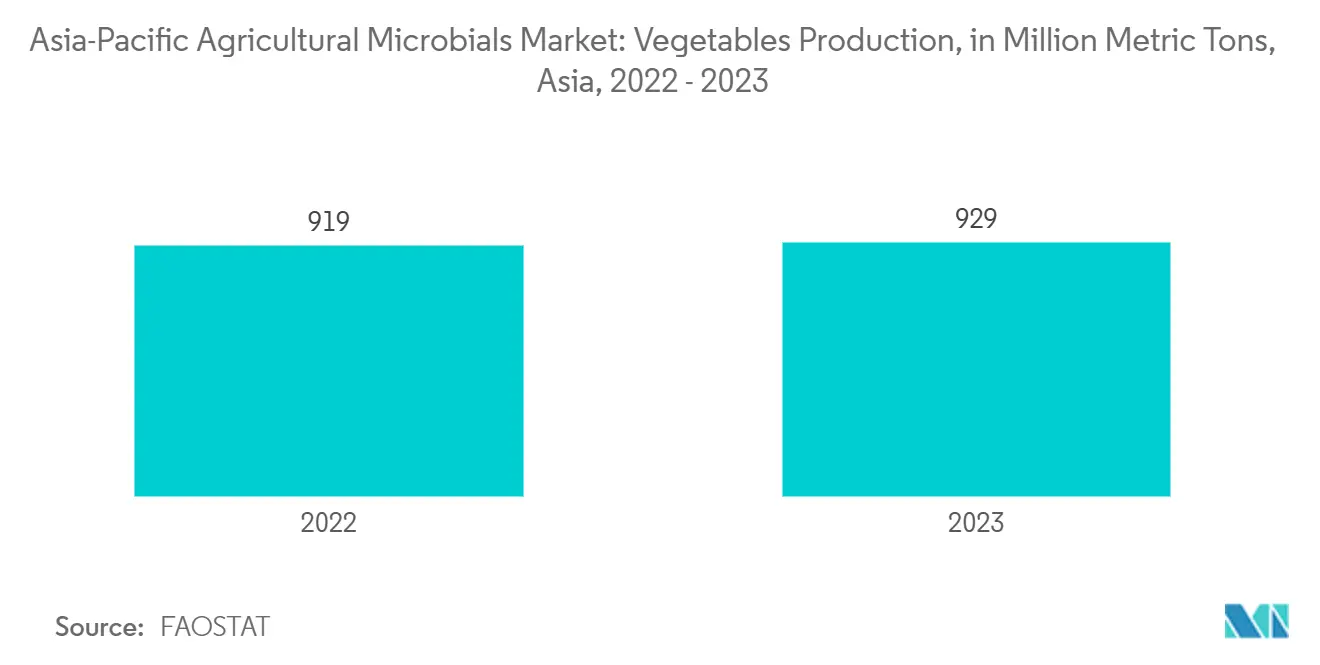
India Leads the Market in the Region
India's agricultural landscape, characterized by diverse climatic zones and soil types, establishes the country as one of the world's major crop producers. The agricultural sector maintains high productivity across rice, wheat, corn, and soybeans, contributing to increased adoption of microbial solutions. Organic agriculture has grown substantially due to improved living standards, heightened health awareness, and increased demand for quality food products. FiBL Statistics reports that in 2022, the organic cultivation area reached 4.72 million hectares, representing a 78% increase from the previous year. This expansion has accelerated the adoption of agricultural microbials across the region.
India continues to advance its research and development in agricultural microbials to address farmer requirements. In 2023, the Indian Council of Agricultural Research Institute of Spices Research (ICAR-IISR), Kozhikode developed 'Tricholime', a new granular lime-based Trichoderma formulation. This product combines Trichoderma and Lime in a single application, simplifying the process for farmers. The expanding organic cultivation area and continuous microbial product innovation position India to maintain its market dominance during the forecast period.
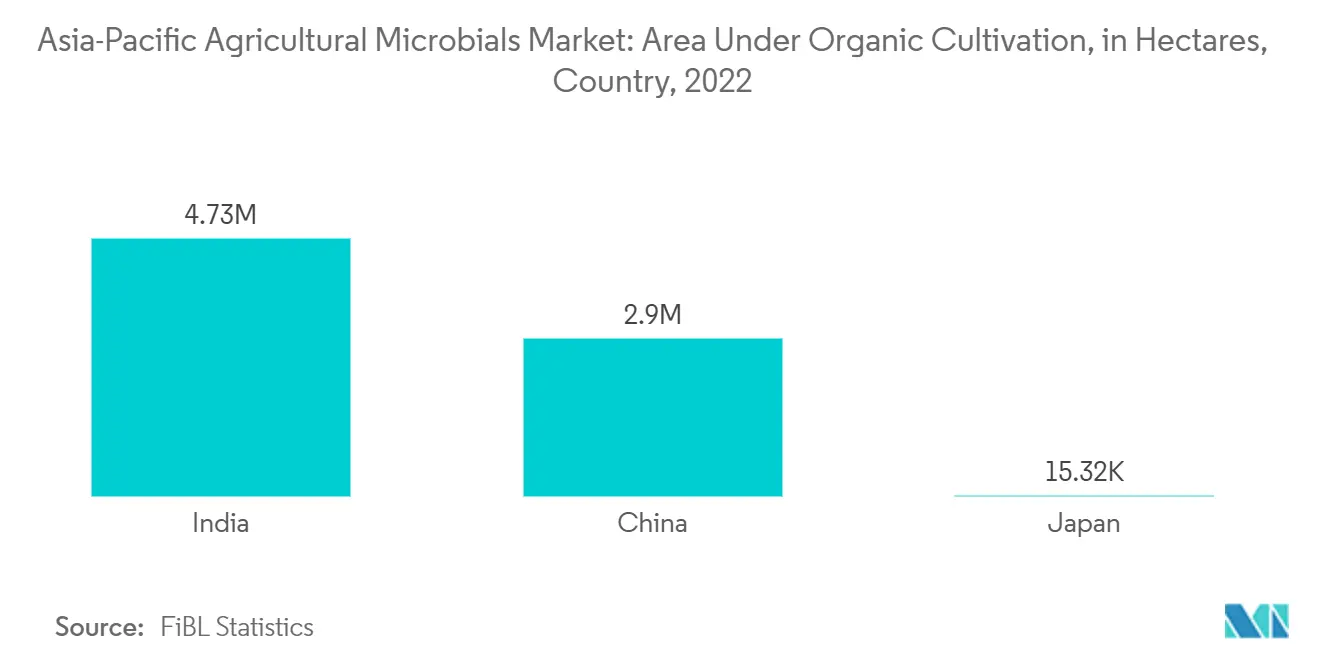
Competitive Landscape
The Asia-Pacific Agricultural Microbial Market is fragmented in structure. The major players in the market are BASF SE, Bayer Cropscience AG, UPL, Koppert B.V., and Corteva Agriscience. The market players are involved in various strategic developments like acquisitions, product innovations, and expansions.
Asia-Pacific Agricultural Microbial Industry Leaders
BASF SE
Bayer Cropscience AG
Koppert B.V
Corteva Agriscience
UPL
- *Disclaimer: Major Players sorted in no particular order
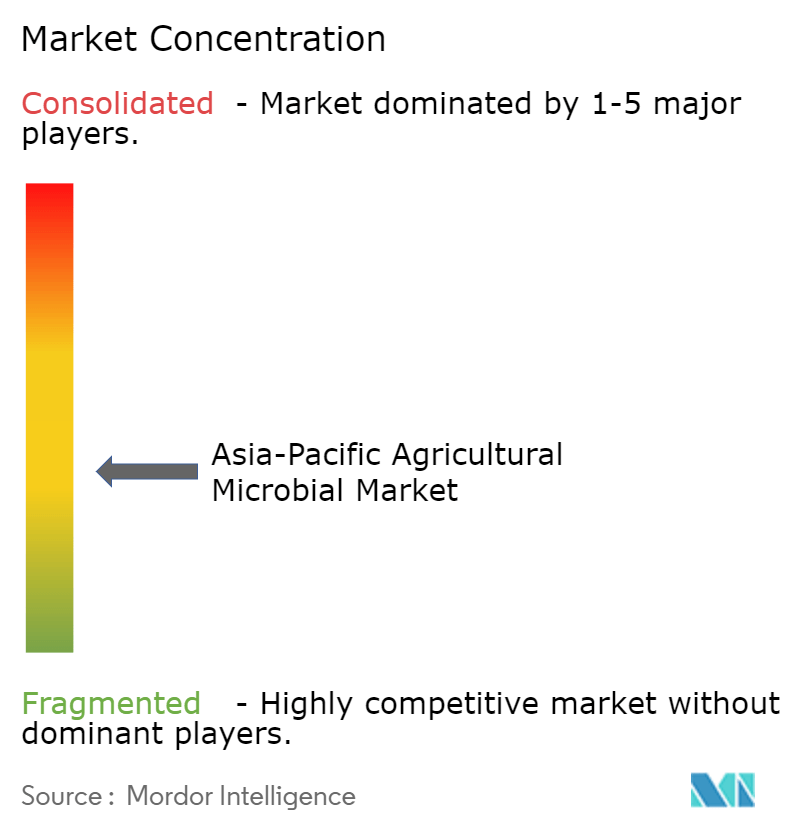
Recent Industry Developments
- April 2024: The Indian Institute of Spices Research (IISR), Kozhikode introduced three microbial formulations (Bactolime, Bactogypsum, and Trichogypsum) using their patent-pending technology to enhance agricultural productivity.
- January 2024: Novozymes and Chr. Hansen, a microbial solution provider for plants, merged to form Novonesis Group through a statutory merger. The combined organization operates as a global bio-solutions provider.
Asia-Pacific Agricultural Microbial Market Report Scope
Agricultural microbials are beneficial microorganisms used in farming to improve soil health, enhance plant growth, and protect crops from pests and diseases. They support sustainable agriculture by promoting nutrient availability and reducing the need for chemical inputs. The Asia-Pacific Agricultural Microbial Market is segmented based on type (bacteria, fungi, virus, and others), by function (amendment and crop protection), by application (grains and cereals, pulses and oilseeds, commercial crops, fruits and vegetables, and other crop types), by formulation (dry formulation and liquid formulation), and by geography (China, Japan, India, Australia, and others). The report offers the market size and forecasts regarding value (USD) for all the above segments.
| Bacteria |
| Fungi |
| Virus |
| Others |
| Ammendment |
| Crop Protection |
| Grains and Cereals |
| Pulses and Oilseeds |
| Commercial Crops |
| Fruits and Vegetables |
| Other Crop Types |
| Dry Formulation |
| Liquid Formulation |
| China |
| Japan |
| India |
| Australia |
| Others |
| Type | Bacteria |
| Fungi | |
| Virus | |
| Others | |
| Function | Ammendment |
| Crop Protection | |
| Application | Grains and Cereals |
| Pulses and Oilseeds | |
| Commercial Crops | |
| Fruits and Vegetables | |
| Other Crop Types | |
| Formulation | Dry Formulation |
| Liquid Formulation | |
| Geography | China |
| Japan | |
| India | |
| Australia | |
| Others |
Key Questions Answered in the Report
How big is the Asia-Pacific Agricultural Microbial Market?
The Asia-Pacific Agricultural Microbial Market size is expected to reach USD 2.60 billion in 2025 and grow at a CAGR of 19.70% to reach USD 5.20 billion by 2030.
What is the current Asia-Pacific Agricultural Microbial Market size?
In 2025, the Asia-Pacific Agricultural Microbial Market size is expected to reach USD 2.60 billion.
Who are the key players in Asia-Pacific Agricultural Microbial Market?
BASF SE, Bayer Cropscience AG, Koppert B.V, Corteva Agriscience and UPL are the major companies operating in the Asia-Pacific Agricultural Microbial Market.
What years does this Asia-Pacific Agricultural Microbial Market cover, and what was the market size in 2024?
In 2024, the Asia-Pacific Agricultural Microbial Market size was estimated at USD 2.09 billion. The report covers the Asia-Pacific Agricultural Microbial Market historical market size for years: 2019, 2020, 2021, 2022, 2023 and 2024. The report also forecasts the Asia-Pacific Agricultural Microbial Market size for years: 2025, 2026, 2027, 2028, 2029 and 2030.
Page last updated on:
Asia-Pacific Agricultural Microbial Market Report
Statistics for the 2025 Asia-Pacific Agricultural Microbial market share, size and revenue growth rate, created by Mordor Intelligence™ Industry Reports. Asia-Pacific Agricultural Microbial analysis includes a market forecast outlook for 2025 to 2030 and historical overview. Get a sample of this industry analysis as a free report PDF download.
